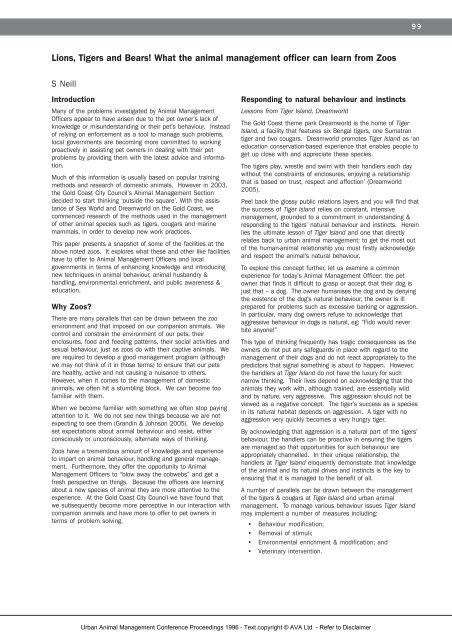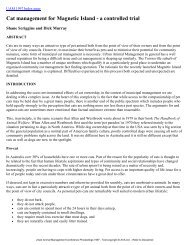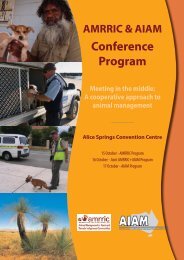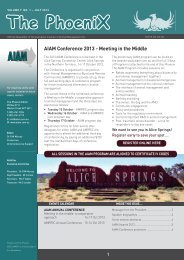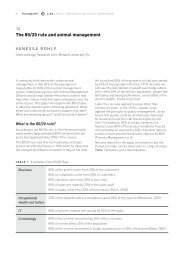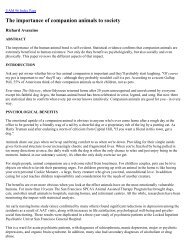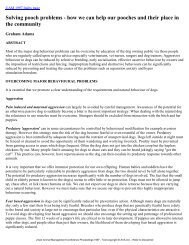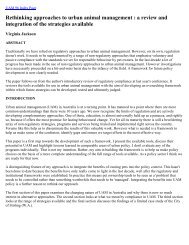Lions, Tigers & Bears! - Australian Institute of Animal Management Inc
Lions, Tigers & Bears! - Australian Institute of Animal Management Inc
Lions, Tigers & Bears! - Australian Institute of Animal Management Inc
Create successful ePaper yourself
Turn your PDF publications into a flip-book with our unique Google optimized e-Paper software.
99<strong>Lions</strong>, <strong>Tigers</strong> and <strong>Bears</strong>! What the animal management <strong>of</strong>ficer can learn from ZoosS NeillIntroductionMany <strong>of</strong> the problems investigated by <strong>Animal</strong> <strong>Management</strong>Officers appear to have arisen due to the pet owner’s lack <strong>of</strong>knowledge or misunderstanding or their pet’s behaviour. Instead<strong>of</strong> relying on enforcement as a tool to manage such problems,local governments are becoming more committed to workingproactively in assisting pet owners in dealing with their petproblems by providing them with the latest advice and information.Much <strong>of</strong> this information is usually based on popular trainingmethods and research <strong>of</strong> domestic animals. However in 2003,the Gold Coast City Council’s <strong>Animal</strong> <strong>Management</strong> Sectiondecided to start thinking ‘outside the square’. With the assistance<strong>of</strong> Sea World and Dreamworld on the Gold Coast, wecommenced research <strong>of</strong> the methods used in the management<strong>of</strong> other animal species such as tigers, cougars and marinemammals, in order to develop new work practices.This paper presents a snapshot <strong>of</strong> some <strong>of</strong> the facilities at theabove noted zoos. It explores what these and other like facilitieshave to <strong>of</strong>fer to <strong>Animal</strong> <strong>Management</strong> Officers and localgovernments in terms <strong>of</strong> enhancing knowledge and introducingnew techniques in animal behaviour, animal husbandry &handling, environmental enrichment, and public awareness &education.Why Zoos?There are many parallels that can be drawn between the zooenvironment and that imposed on our companion animals. Wecontrol and constrain the environment <strong>of</strong> our pets, theirenclosures, food and feeding patterns, their social activities andsexual behaviour, just as zoos do with their captive animals. Weare required to develop a good management program (althoughwe may not think <strong>of</strong> it in those terms) to ensure that our petsare healthy, active and not causing a nuisance to others.However, when it comes to the management <strong>of</strong> domesticanimals, we <strong>of</strong>ten hit a stumbling block. We can become to<strong>of</strong>amiliar with them.When we become familiar with something we <strong>of</strong>ten stop payingattention to it. We do not see new things because we are notexpecting to see them (Grandin & Johnson 2005). We developset expectations about animal behaviour and resist, eitherconsciously or unconsciously, alternate ways <strong>of</strong> thinking.Zoos have a tremendous amount <strong>of</strong> knowledge and experienceto impart on animal behaviour, handling and general management.Furthermore, they <strong>of</strong>fer the opportunity to <strong>Animal</strong><strong>Management</strong> Officers to “blow away the cobwebs” and get afresh perspective on things. Because the <strong>of</strong>ficers are learningabout a new species <strong>of</strong> animal they are more attentive to theexperience. At the Gold Coast City Council we have found thatwe subsequently become more perceptive in our interaction withcompanion animals and have more to <strong>of</strong>fer to pet owners interms <strong>of</strong> problem solving.Responding to natural behaviour and instinctsLessons from Tiger Island, DreamworldThe Gold Coast theme park Dreamworld is the home <strong>of</strong> TigerIsland, a facility that features six Bengal tigers, one Sumatrantiger and two cougars. Dreamworld promotes Tiger Island as ‘aneducation conservation-based experience that enables people toget up close with and appreciate these species.The tigers play, wrestle and swim with their handlers each daywithout the constraints <strong>of</strong> enclosures, enjoying a relationshipthat is based on trust, respect and affection’ (Dreamworld2005).Peel back the glossy public relations layers and you will find thatthe success <strong>of</strong> Tiger Island relies on constant, intensivemanagement, grounded to a commitment in understanding &responding to the tigers’ natural behaviour and instincts. Hereinlies the ultimate lesson <strong>of</strong> Tiger Island and one that directlyrelates back to urban animal management: to get the most out<strong>of</strong> the human-animal relationship you must firstly acknowledgeand respect the animal’s natural behaviour.To explore this concept further, let us examine a commonexperience for today’s <strong>Animal</strong> <strong>Management</strong> Officer: the petowner that finds it difficult to grasp or accept that their dog isjust that – a dog. The owner humanises the dog and by denyingthe existence <strong>of</strong> the dog’s natural behaviour, the owner is illprepared for problems such as excessive barking or aggression.In particular, many dog owners refuse to acknowledge thataggressive behaviour in dogs is natural, eg: “Fido would neverbite anyone!”This type <strong>of</strong> thinking frequently has tragic consequences as theowners do not put any safeguards in place with regard to themanagement <strong>of</strong> their dogs and do not react appropriately to thepredictors that signal something is about to happen. However,the handlers at Tiger Island do not have the luxury for suchnarrow thinking. Their lives depend on acknowledging that theanimals they work with, although trained, are essentially wildand by nature, very aggressive. This aggression should not beviewed as a negative concept. The tiger’s success as a speciesin its natural habitat depends on aggression. A tiger with noaggression very quickly becomes a very hungry tiger.By acknowledging that aggression is a natural part <strong>of</strong> the tigers’behaviour, the handlers can be proactive in ensuring the tigersare managed so that opportunities for such behaviour areappropriately channelled. In their unique relationship, thehandlers at Tiger Island eloquently demonstrate that knowledge<strong>of</strong> the animal and its natural drives and instincts is the key toensuring that it is managed to the benefit <strong>of</strong> all.A number <strong>of</strong> parallels can be drawn between the management<strong>of</strong> the tigers & cougars at Tiger Island and urban animalmanagement. To manage various behaviour issues Tiger Islandmay implement a number <strong>of</strong> measures including:• Behaviour modification;• Removal <strong>of</strong> stimuli;• Environmental enrichment & modification; and• Veterinary intervention.Urban <strong>Animal</strong> <strong>Management</strong> Conference Proceedings 1996 - Text copyright © AVA Ltd - Refer to Disclaimer
100Selina Neill: <strong>Lions</strong>, <strong>Tigers</strong> and <strong>Bears</strong>! What the animal management <strong>of</strong>ficer can learn from ZoosThe following table shows several problems that Tiger Island staff had to overcome and the management strategies that wereimplemented. What is striking is the similarity between the problems and resulting strategies with the tigers, with those weexperience with dogs.Identified Problem <strong>Management</strong> Strategy CategoryOne <strong>of</strong> the male tigers had developed a habit <strong>of</strong>staying at the back <strong>of</strong> the exhibit near the accessgate. In this position not only was he difficult forthe park visitors to see, but he posed a danger tohandlers entering the exhibit.Syringes <strong>of</strong> vinegar were kept by the access gateand the tiger was squirted every time he skulkedat the gate. He was rewarded when he movedaway from the gate.The cougars were being temporarily housed in thewestern wing <strong>of</strong> the complex while their newenclosure was under construction. The tigerswere ‘eyeballing’ the cougars, making the cougarsnervous. Handling <strong>of</strong> the tigers became moredifficult in the area as they became increasinglyfixated with the cougars’ presence.The tigers are attracted to strong scents such asinsect repellent, juniper and Singapore daisy.They may react by immersing themselves in it orlicking the source. The longer they do this themore ‘go<strong>of</strong>y’ they act and they can become verypossessive <strong>of</strong> the source.Female cougars are extremely noisy callers duringoestrus.Table 1: Some behavioural problems & strategies at Tiger IslandThe handlers solved the problem by covering thecougars’ enclosure with shade cloth.Recognising the scents that have this affect andlimiting the tiger’s exposure to them.As there were no plans to breed the cougars theywere de-sexed to prevent this noise nuisance.BehaviourmodificationRemoval <strong>of</strong> stimuliEnvironmentalmodificationVeterinaryinterventionThe level and quality <strong>of</strong> the interaction between tiger and handlerthat can be seen at Tiger Island demonstrates what can beachieved when you commit to understanding and responding tothe animal’s natural behaviour. There is no superhuman animalhandling skills involved – the only thing that is extraordinary withthe methods employed is their level <strong>of</strong> application. When mostpet owners give up or find that ignoring the problem is easier,Tiger Island perseveres, and the results are awesome.Environmental enrichmentLessons from Polar Bear Shores, Sea WorldOne problem that zoos must battle is the development <strong>of</strong>stereotypic behaviour in their animals. A stereotypy is arepeated, relatively invariant sequence <strong>of</strong> movements, whichhas no obvious purpose (Fraser & Broom 1997), eg: pacing,wind-sucking, head-shaking, etc. It can be observed in a widerange <strong>of</strong> animals, most <strong>of</strong> which are held in captivity includinghorses, pigs, chickens, primates and carnivores. To relievestereotypic behaviour, zoos strive to employ appropriateenvironmental enrichment strategies.In general, “environmental enrichment” means providing acomplex and diverse environment that increases the possibilitythat the captive animal’s own behaviour will produce what itneeds: finding food, demarcating a territory, building a nest,maintaining its physical conditions, escaping conspecifics, orhiding. An animal with behavioural options will be better able tocope with stressful events in its surroundings or alleviateboredom. Behavioural options can be improved by increasingthe complexity and variability <strong>of</strong> the environment physically,sensorily and socially (Carlstead 1996). Zoos have recognisedthat enrichment strategies improve the psychological well being<strong>of</strong> their animals as well as relationships between the animalsand the keepers (Gregory & Tribe 2003) and have embraced theconcept with considerable enthusiasm.Environmental enrichment has become a buzz term for thecompanion animal world too. It is seen as a managementstrategy for unwanted behaviours such as barking, digging andfence pacing. However, the enrichment strategies implementedby the average pet owner appear to be limited to physicalenrichment objects. There is a large commercial market forthese items and one needs only to visit a pet store to see adizzying array <strong>of</strong> chew toys, throw toys and food puzzles.Unfortunately, the novelty <strong>of</strong> these objects tends to wear <strong>of</strong>f ifthe item is used too frequently or remains in the enclosure forlong periods <strong>of</strong> time (Gregory & Tribe 2003). Furthermore,environmental enrichment is not just about throwing a few toysto the animal. The concept also encapsulates social enrichment,sensory stimulation, feeding strategies and behaviouralconditioning and training.Sea World on the Gold Coast has world-class facilities &management programs for their marine mammals. One <strong>of</strong> theirlatest attractions, Polar Beach Shores, is a prime example <strong>of</strong>environmental enrichment at its best.Enclosure furnishings and sensory stimulationThe Polar Bear Shores complex includes an outdoor exhibit thatprovides viewing for the public, an outdoor <strong>of</strong>f display yard andfive air-conditioned pens. The outdoor exhibit has beenconstructed to resemble the natural tundra environment in thesummertime. It covers various elevations and includes a large,main saltwater swimming pool as well as three smallerfreshwater pools. The freshwater pools include waterfalls andare connected by a stream. Aromatic spices and otherstimulators may be smeared and distributed at varyingelevations throughout the exhibit and novel objects are regularlyrotated throughout the facility, including <strong>of</strong>f exhibit areas.The exhibit has a number <strong>of</strong> environmental enhancements thatcan all be controlled from the keeper <strong>of</strong>fice. Chilled watervapour can be deployed from 270 nozzles in different areas andrain can be generated across the entire exhibit anywhere from aheavy pour to a light mist. Winds up to 25 kilometres per hourcan be generated throughout the exhibit by six giant fansrecessed into the walls (Nicosia & Haynes-Lovell 2003).Feeding strategiesMany wild animals spend much <strong>of</strong> their time feeding andforaging. By contrast, captive mammals <strong>of</strong>ten receive their foodin a single daily serving and are largely inactive as a result. It ispossible to alter the way in which captive animals are fed andthereby increase their activity levels to approach wild norms.Individual feeding bouts can be prolonged by the provision <strong>of</strong>food that is difficult to process. More frequent feedings anddistribution <strong>of</strong> food throughout an enclosure effectively providediversion and relieve boredom (Maple & Perkins 1996).Urban <strong>Animal</strong> <strong>Management</strong> Conference Proceedings 1996 - Text copyright © AVA Ltd - Refer to Disclaimer
101At Polar Bear Shores an assortment <strong>of</strong> food is scatteredthroughout the exhibit in the morning before access is permittedto the bears. Foods such as watermelon are frozen into giantice blocks and may be presented in a variety <strong>of</strong> containers thatcan be manipulated or floated in the pools and other snacks areconcealed in toys. Sometimes live fish are added to the exhibitpools, giving the bears a positive hunting experience.Behavioural conditioning and trainingTraining is another type <strong>of</strong> enrichment event <strong>of</strong>fered to thebears. In an environment with superabundant food resourcesand in the absence <strong>of</strong> predator or prey, zoo animals are <strong>of</strong>teninactive and/or exhibit stereotypic behaviours. Biologicallysuitable training can provide a “new interest in life” thusincreasing activity levels and/or decreasing stereotypy (Mellen& Ellis 1996). The bears and the keepers work in protectedcontact, meaning that they are not in the same enclosure andproximity. Husbandry training is therefore conducted viaoperant conditioning, which means the bears “operate” on theenvironment to bring about some change that leads to a reward.The enrichment strategies employed by Sea World weresuccessful in reducing the stereotypic behaviour <strong>of</strong> Kanook, apolar bear that had come to the facility with a long history <strong>of</strong>stereotypy. At her original home in Arizona, Kanook spent morethan 50% <strong>of</strong> her time on exhibit engaged in stereotypicbehaviour, pacing on average 3-4 hours per day. After a year atSea World, Kanook’s chronic stereotypy had reduced by 99.8%(Nicosia & Haynes-Lovell 2003).Application in urban animal managementThe parallels between the above examples and urban animalmanagement is that the <strong>Animal</strong> <strong>Management</strong> Officer will <strong>of</strong>tencome across problems that can be improved by adequateenvironmental enrichment. It would be hugely advantageous ifthe <strong>of</strong>ficer were able to develop appropriate problem solvingstrategies and communicate these methods to the pet owner inorder to alleviate the problem being experienced by the community.Custom built enclosures are obviously not within the financialscope <strong>of</strong> the average dog owner and certainly it is not necessaryconsidering the species has adapted to living with humans andmost enjoy regular time outside their enclosures, eg: walkingwith their owner. However, some consideration and imaginationshould still be given, particularly to those companion animalskept in restrictive conditions such as birds or indoor cats. Allpet owners can easily adopt some <strong>of</strong> the methods used at zoosin order to provide a stimulating environment for their pets andsubsequently alleviate boredom and associated nuisanceactivity.The following table gives some basic examples <strong>of</strong> enrichmentactivities for dogs. This kind <strong>of</strong> information could be presentedby councils in a brochure or fact sheet and made available todog owners to enhance their current management strategy.TYPEEXAMPLESSocial enrichment - Provide opportunities for the dog to interact with other dogs, animals and people;- Take the dog walking in public areas;- Regularly attend obedience training classes;- Allow the dog to interact with guests.Sensory stimulation- visual- auditory- olfactory- physical- taste- Provide toys and rotate their use to retain novelty-value;- Stuff food toys, eg: Kongs, with different foods each day to provide a range <strong>of</strong> tastes,smells and textures;- Provide regular outings in different environments, eg: dog can experience salt waterswimming, fresh water swimming, bush settings, long grass, etc.Feeding strategies - Make the dog work for its food. Instead <strong>of</strong> serving up its morning meal in a bowl,distribute kibble throughout the enclosure and let the dog forage for its food;- Freeze bits <strong>of</strong> meat on a string in ice and hang from the washing line. When the icemelts, the meat will drop to the ground.Behavioural conditioning& training- Provide regular training. From getting the dog to settle quietly on a mat to performing a“high-five”, training is fun, stimulating and beneficial for both dog and owner;- Practice for visits to the vet. Get the dog used to standing for examinations, havingeyes, ears, mouth and paws checked.Table 2: Examples <strong>of</strong> environmental enrichment for dogsSomatic communicationLessons from the pinniped facility, Sea WorldKeepers at the pinniped (seals, sea lions) facility at Sea Worldhave observed physical forms <strong>of</strong> communication that assistthem when performing general care and conditioning <strong>of</strong> theanimals. The keepers work in free contact (in the sameenclosure and within close proximity) with the animals, some <strong>of</strong>which can grow to a massive 200 kg+ and measure over 200cm tall.Despite their benign appearance, seals and sea lions are quitecapable <strong>of</strong> aggressive behaviour and the males are particularlyreactive to perceived challenges to their dominance. It istherefore crucial that the keepers be perceptive to every nuanceand signal given by the animals to ensure their safety.Sea World has subsequently researched somatic communicationin pinnipeds, leading to the development <strong>of</strong> broad workingconcepts that are listed by McAuliffe & Smith (2003) as:1. Unbroken eye contact <strong>of</strong>ten signals aggressive intent/fear;2. Breaking eye contact by blinking or head turning <strong>of</strong>tenelicits a reciprocal response;3. Moving the mouth away from a person or animals isusually a signal <strong>of</strong> non-aggressive intent. This includessuch behaviours as head turning, <strong>of</strong>ten with an exaggeratedmouth open. Apparent preoccupation <strong>of</strong> an object orscent on the ground is an obvious signal on occasion; and4. Movements that place an animal’s body in the posturefrom which an efficient attack or defence can be made,can <strong>of</strong>ten be defused by <strong>of</strong>fering calming signals such asbreaking eye contact and head turning.Urban <strong>Animal</strong> <strong>Management</strong> Conference Proceedings 1996 - Text copyright © AVA Ltd - Refer to Disclaimer
102Selina Neill: <strong>Lions</strong>, <strong>Tigers</strong> and <strong>Bears</strong>! What the animal management <strong>of</strong>ficer can learn from ZoosMcAuliffe & Smith (2003) report that Californian Sea <strong>Lions</strong>respond to blinking and head turning by increasing the frequencywith which they perform these behaviours. Often when the sealions are anxious they will appear to relax when the keeperspresent these behaviours. Reducing the time that direct eyecontact was made with an <strong>Australian</strong> Sea Lion appeared tocause it to appear more relaxed during training sessions. Thebenefit <strong>of</strong> these developments is that the keepers have beenable to improve their ability to communicate to these animalsconcepts such as lack <strong>of</strong> aggressive intent and defuse anxietylevels.These methods are not new, having first been described byRugaas (1997) in her work on calming signals in canines.However, we have found it ironic that we went to zoos in order tolearn techniques outside the canine training world and ended upbeing guided back to dogs!The benefits to <strong>Animal</strong> <strong>Management</strong> Officers in learning moreabout somatic communication are as follows:• Officers can defuse aggressive dogs in the field bysignalling confidence and lack <strong>of</strong> aggressive intentthrough posture, head turning, rear approach and yawning:• Capturing stray animals and caring for shelter animals ismade easier by using species specific calming signals toreduce the animal’s anxiety levels and convey lack <strong>of</strong>aggressive intent;• Somatic communication techniques can be incorporatedinto bite prevention presentations and educationalmaterial for the community.Not only do somatic communication techniques improve theefficiency and effectiveness <strong>of</strong> field tasks such as impoundingand complaint investigation, but they benefit organisationalworkplace health and safety too.Public awareness and educationZoo signsThe collections <strong>of</strong> animals found in zoos have the potential toprovide the public with unique educational opportunities notreadily available elsewhere. The declines <strong>of</strong> wild populations <strong>of</strong>many species now preclude their observation in the wild, thusimparting great import to the information a zoo can provide. Assuch, modern zoos have the ability as well as the responsibilityto provide visitors with synthesized lessons about animalanatomy, physiology, ecology, and behaviour, ultimately instillingan appreciation <strong>of</strong> each species and its particular adaptations tothe natural environment (Mellen & Ellis 1996).Walk around your local zoo and you will notice a number <strong>of</strong>educational signs distributed throughout. These signs generallyconvey some kind <strong>of</strong> basic information about a particularspecies on exhibit, their natural habitat, population, feedinghabits, etc. However, the more engaging signs for the zoovisitor are those that provide a broader learning experienceabout the animal, making the zoo visitor an active participant.For example, a sign may depict the binocular vision range orcolour vision <strong>of</strong> a particular species in comparison to that <strong>of</strong> ahuman’s, so that the viewer may experience things and thusgain an appreciation <strong>of</strong>, the animal’s perspective.Councils too have a number <strong>of</strong> important animal managementmessages to convey to the community and have an incidentalaudience in those frequenting public areas such as parks. It issuggested that councils adopt a similar signage strategy tozoos by installing educational signs in these public areas,particularly in the popular dog parks. The objective <strong>of</strong> thesignage is to educate the public on various companion animalmanagement issues, promoting improved management <strong>of</strong> petsat home and in the community.Some suggestions include:· An explanation <strong>of</strong> some canine body postures (particularlyuseful in designated <strong>of</strong>f leash areas where an array <strong>of</strong>body postures are likely to be seen and need to beunderstood by the handler);· Environmental enrichment strategies;· Tips to manage barking; and· Basic obedience lessons, eg: sit, drop, stay, leashmanners.ConclusionIn the classic movie The Wizard <strong>of</strong> Oz, the characters Dorothy,Scarecrow and Tin Man are required to walk through a darkforest in order to get to the fabled city <strong>of</strong> Oz. The charactersfear that there may be wild animals in the forest that will harmthem – animals such as “lions, tigers and bears!” This line isrepeated like a mantra as they venture deeper into the forest.Of course they end up meeting a lion, which, contrary to theirfears, ends up helping them.Innovation and change can cause anxiety for some. However, farfrom being frightening, the lions, tigers and bears that we havemet (both literally and figuratively) have opened up a tremendousnew world for us. Our scope as <strong>Animal</strong> <strong>Management</strong> Officers,with our roles in animal handling, animal behaviour and publiceducation, has increased greatly.To <strong>Animal</strong> <strong>Management</strong> Officers and councils who are interestedin learning new ways to approach old situations, it isdefinitely worthwhile to take the time to approach facilities suchas zoos and wildlife sanctuaries to learn how they manage theiranimals. Most facilities are very accommodating and appreciatethe opportunity to promote awareness <strong>of</strong> their activities.AcknowledgementsThe author would like to thank Dreamworld and Sea World fortheir assistance with this project. Special thanks to all thekeepers involved, particularly Patrick Martin-Vegue, KerrieHaynes-Lovell and Darryl Pearce.ReferencesCarlstead, K. (1996). ‘Effects <strong>of</strong> captivity on the behaviour <strong>of</strong>wild animals’. In: Kleiman, G., Allen, M., Thompson, K. &Lumpkin, S. (eds) Wild Mammals in Captivity: Principles andTechniques. The University <strong>of</strong> Chicago Press: Chicago.Dreamworld (2005). Website. Viewed 24 October 2005Fraser, A. and Broom, D. (1997). Farm <strong>Animal</strong> Behaviour andWelfare. In: Nicosia, E. & Haynes-Lovell, K. (2003). Usingmanagement as a method to decrease stereotypic behaviourin captiveSelina NeillSelina Neill is the Project & Public Awareness Officer for the<strong>Animal</strong> <strong>Management</strong> Section <strong>of</strong> the Gold Coast City Council.She has been in Local Government for eleven years and has heldprevious positions as an <strong>Animal</strong> <strong>Management</strong> Officer and<strong>Animal</strong> <strong>Management</strong> Inspector. She is currently studying for agraduate qualification in Public Sector <strong>Management</strong>. She wasthe team leader <strong>of</strong> the AMO Team <strong>of</strong> the Year 2002 and wasawarded AMO <strong>of</strong> the Year 2004.Urban <strong>Animal</strong> <strong>Management</strong> Conference Proceedings 1996 - Text copyright © AVA Ltd - Refer to Disclaimer


